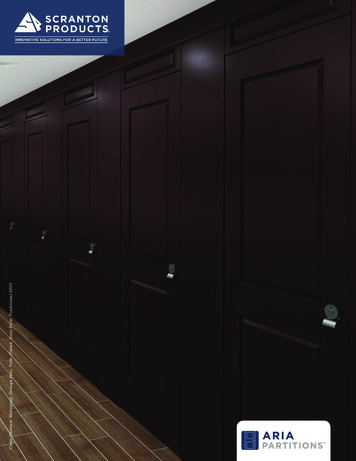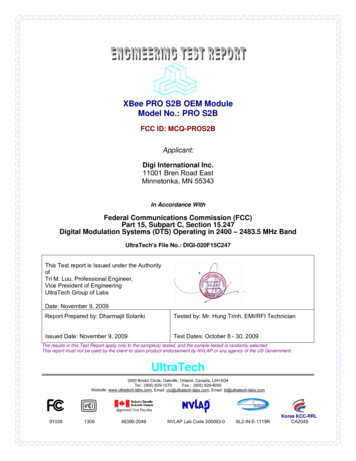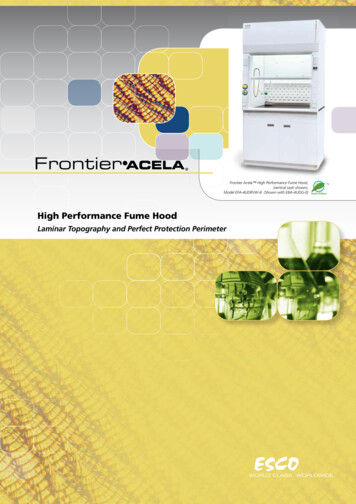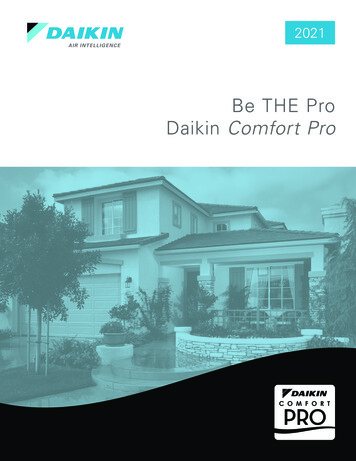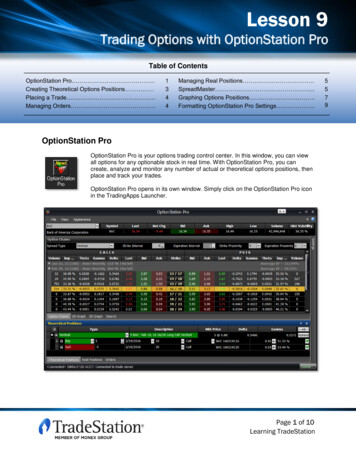
Transcription
pro powerpeel
table ofcontents2 Introduction4 Chemical Peels: An Overview10 Introducing the Pro Power Peel15 Products and Key Ingredients26 Application Method34 Post-Treatment Guidelines36 FAQs Dermalogica, 2018No portion of this manual, or any of the partsthereof, may be duplicated in any format withoutprior written permission from Dermalogica.
introductionCell turnover slows dramatically as we age, fromapproximately 20 days in younger and middleaged adults, up to over 30 days in older adults.As this happens, it affects the skin’s appearanceand texture in a variety of ways. From fine linesand wrinkles to acne and hyperpigmentation,chemical peels are one of the most effectiveways to address these changes. But they’re nota one-size-fits-all treatment: for optimal results, apeel should be strong enough to accelerate cellturnover but not so powerful as to induce severeskin inflammation.Since every client’s skin is different, the bestsolution is to give you the tools you need to createcompletely customised peels — which is wherethe inspiration for the all-new Pro Power Peelcollection came from. Our strongest and fastestpeel yet, it enables you to professionally tailoreach treatment to your client’s skin concerns,helping them achieve their healthiest-looking skinever.2 Pro Power Peel Training ManualDermalogica 3
chemical peels:an overviewChemical peels are an excellent treatment choice for a wide range of skin concerns, from acne andhyperpigmentation to advanced signs of ageing. Despite their varying uses, most peels work the same way:they remove the skin’s outermost layers to stimulate cell renewal and cell turnover, improving skin’s texture andappearance.professional peels vs. at-home peelsPeels designed to be applied by licensed professional skin therapists – like Pro Power Peel – tend to bemore concentrated, at a very low pH, and customisable to deliver more dramatic results. These formulasare usually not available to clients for self-application.Peels designed to be used by clients at home tend to be lighter in nature. They are ideal for quick, easyremoval of dulling surface cells, as well as building the skin's tolerance for stronger professional peels andmaintaining results in between professional treatments.Peels are classified into four categories, based on penetration depth and their effect on the skin:very superficial peelssuperficial peelsUsed to treat acne, hyperpigmentation andsigns of ageing, these peels affect the StratumCorneum and don’t penetrate beyond thegranular level (Stratum Granulosum).These peels are used to exfoliate skin in theepidermal layer down to the Basal Layer (orStratum Germinativum). They treat signs ofageing, acne and hyperpigmentation.medium-depth peelsdeep peelsTypically performed by a medical professional,these peels reach the upper layers of thedermis down to the papillary dermis. They treatsuperficial scars and solar keratoses as well ashyperpigmentation and signs of ageing.Performed only by medical professionals, deeppeels remove the papillary dermis and reach thereticular dermis to address severe photoageing,deep wrinkles and scars.4 Pro Power Peel Training ManualDermalogica 5
what makes a peel effective?The efficacy of a chemical peel depends on a number of factors, from the client’s skin condition to the skintherapist’s application method. Taking each of these factors into consideration during the treatment process willhelp to optimise your client’s results.skin healthGenerally speaking, healthy skin is less likely to experience adverse reactions to a chemical peel. Cracked ordehydrated skin allows chemical peel agents to penetrate further, which can intensify stinging and burning.skin primingMany clients can benefit from preliminary treatments or products that “prime” the skin, helping to prepare it forthe high activity of a chemical peel – particularly if they are new to peels. Priming with at-home peels or otherexfoliating agents helps to acclimate skin and ensure that the client receives the best possible result from theirpeel.skin prepJust before the peel, it’s important to “prep” the skin. Follow the Pro Power Peel step-by-step instructionsclosely to ensure that the client’s skin is thoroughly double cleansed and degreased; this helps the chemicalpeel penetrate skin evenly and effectively.peeling agent(s), solution pH and concentrationAlpha Hydroxy Acids (AHAs) and Beta Hydroxy Acids (BHAs) both have different molecular sizes, and thereforepenetrate skin to different degrees. Because of this, each acid lends itself to the treatment of different skinconcerns. Peel pH and concentration play a role, too; for AHAs and BHAs, the pH of the solution is just asimportant as the concentration of the acid. Peeling agents with a low pH are more acidic and better able totarget concerns like pigmentation and wrinkles.application methodThe way a peel is applied can play a role in penetration depth. Massaging can increase product absorption –but because it also increases blood circulation, it can lead to higher chances of erythema, sensitivity orinflammation. Application tools can determine absorption, too: gauze allows more solution to be applied to theskin than a brush. Cotton swabs may be preferable when you need more control to spot-treat or target preciseareas.6 Pro Power Peel Training ManualDermalogica 7
chemical peeling agentskeratolytic agents (AHAs and BHAs)Keratolytic agents break apart the snap-like bonds (corneodesmosomes) that hold dead skin cells (corneocytes)together, allowing them to shed more easily and therefore improving the skin’s texture and overall appearance.Widely considered the most versatile group of peeling agents, AHAs (including Lactic Acid, Glycolic Acid,Mandelic Acid and Malic Acid) are water-soluble and can be used at different concentrations for different effectson the skin. Clients can use them at low concentrations on a daily basis to slowly exfoliate over time; used inhigher concentrations they exfoliate the epidermis more quickly, breaking corneodesmosomes at the cellularlevel.BHAs, like Salicylic Acid, are oil-soluble, making them an excellent treatment choice for oily and acne-proneskin. They can actually penetrate the skin through the follicles and sebaceous glands while helping to dissolvefollicular impactions.keratocoagulant agentsKeratocoagulant agents contribute to exfoliation by coagulating the skin’s proteins, contributing to enhancedcell renewal rates and cell turnover. In this reaction, the protein is denatured, similar to an egg white turningwhite as it cooks. This can produce the skin-whitening effect known as “frosting”, particularly in areas ofbreakout or dehydration.pH and acidityIn order for AHAs and BHAs to effectively exfoliate, they must be formulated at a low pH; they’re most effectiveat a pH of 1.0-2.5. The skin’s natural pH is mildly acidic, ranging from 4.5-5.5; exposing it to more acidicconditions contributes to AHAs’ and BHAs’ exfoliating efficacy. The change in pH causes a superficial shock tothe cells, contributing to desquamation and increased cell renewal.8 Pro Power Peel Training ManualDermalogica 9
introducing thepro power peelWhen it comes to chemical peels, we’ve always had a unique perspective. Promoting overall skin health is oneof Dermalogica’s core values. We also believe that regular resurfacing is crucial to accelerate cell turnover andrenewal rates – so we opt for peels that are more frequent and less invasive rather than those that push theskin to the point of severe inflammation and possible scarring.Additionally, we’re constantly looking for ways to give you the flexibility to create completely customised treatmentsfor a range of skin conditions. With this in mind, the skin health experts at The International Dermal Institute andDermalogica are excited to introduce the all-new and fully customisable Pro Power Peel.In addition to being our fastest and strongest peel yet, the Pro Power Peel provides you with a full suite of productsand the flexibility to create bespoke peels that are perfectly suited to each client’s needs. In short, it redefines thepeel experience – and allows you to give clients a different, custom peel with each treatment.the pro peel collectionEach of the peels in this collection is efficacious enough to use alone.Used together, they allow skin therapists to target a broad range of skin concerns:One-Step PrepAdvancedRenewal PeelLeave-on prep solution with Witch Hazel and Alcoholdegreases skin and prepares it for Pro Power Peelsolutions; no removal required.30% Glycolic Acid complexed with Opuntia FlowerExtract and Phytic Acid reduces the appearance ofhyperpigmentation while minimising the appearanceof fine lines and wrinkles.UltraBright Peel30% Lactic Acid complexed with Phytic Acid, MucorFungal Extract, Grape Juice Extract and TangerinePeel brightens and hydrates, reducing theappearance of early signs of ageing and helping toeven skin tone.PowerClear Peel2% Salicylic Acid with 10% Mandelic Acid and15% Malic Acid and a patented Terpineol-ThymolComplex targets blemishes, post-inflammatoryhyperpigmentation and redness.Neutralizing SolutionReady-to-use neutraliser helps soothe the skin andhelps restore its natural pH.10 Pro Power Peel Training ManualDermalogica 11
pro peel summary chartpro peel namePowerClear PeelUltraBright PeelAdvancedRenewal Peelkey featuresSalicylic-Mandelic Acid ComplexLactic Acid-Phytoactive ComplexGlycolic Acid-Cactus Flower Complexkey ingredients2% Salicylic Acid10% Mandelic Acid15% Malic AcidTerpineol-Thymol Complex30% Lactic AcidMucor Fungal ExtractCitrus Reticulata Peel Extract(Tangerine Peel)Vitis Vinifera (Grape) Juice ExtractPhytic Acid30% Glycolic AcidOpuntia Ficus-Indica Flower ExtractPhytic Acidskin conditiontreatedBlemishes, Post-InflammatoryHyperpigmentation, RednessHyperpigmentation, Uneven Skin Tone,Prematurely Aged SkinMature Skin, Fine Lines & Wrinkles,Hyperpigmentationspeed of peel delivery into westmaAs you becomefamiliar with the ProPower Peel Collection,you’ll develop customcombinations thatallow you to effectivelymix, layer and evenspot-apply the peels.which peel is right for my client?If your client is new to peels or doesn't receive them often, consider first recommending an at-home peel,like Rapid Reveal Peel, to help their skin acclimate.(It’s also an excellent way to help clients who regularly receive peels maintain their results betweenprofessional treatments!)Formulated with gentle yet effective 90% Phytic Acid from Rice Bran Extract to increase cell turnoverwhile brightening skin, Rapid Reveal Peel is designed to work synergistically with the Pro Power Peelcollection and is ideal for building the skin’s tolerance leading up to your client’s first professional peel.Before recommending a treatment, always give your client a thorough Face Mapping skin analysis tohelp them make the right choice for their current skin goals and lifestyle.12 Pro Power Peel Training ManualDermalogica 13
pro powerpeel productsand keyingredients14 Pro Power Peel Training ManualDermalogica 15
one-step prepdescriptionThis leave-on peel prep solution with Witch Hazel andAlcohol effectively degreases the skin for greater peelefficacy.benefits Degreases skin in preparation for treatment Optimises subsequent peel performance More efficacious treatments – with fewer layersof acidkey ingredientsHamamelis Virginiana (Witch Hazel) Water acts asa natural astringentAlcohol acts as a skin penetration enhancer tofacilitate peel absorptionLactic Acid exfoliates skinwarnings: This product contains an alpha hydroxy acid (AHA) that may increaseyour skin's sensitivity to the sun and particularly the possibility of sunburn. Usea sunscreen, wear protective clothing, and limit sun exposure while using thisproduct and for a week afterwards. Use only as directed. Contact of the productwith the skin must be of limited frequency or duration. Avoid contact with eyes. Ifirritation persists, discontinue use and consult a physician.16 Pro Power Peel Training ManualDermalogica 17
ultrabright peeldescriptionUltra-effective brightening peel featuring 30% LacticAcid complexed with Rice-derived Phytic Acid,AHA-rich Grape Juice Extract and Mucor FungalExtract, along with Tangerine Peel, helps to reducethe appearance of early signs of ageing and even skintone.benefits Brightens dull skin Minimises the appearance of fine lines Hydrates dry and dull skinkey ingredients30% Lactic Acid stimulates exfoliation by decreasingcorneocyte cohesion while stimulating cell renewaland cell turnover in the epidermisPhytic Acid aids in cell turnover, brightens skin andprovides antioxidant benefitsCitrus Reticulata Peel Extract (Tangerine Peel)improves skin brightness and helps support creationof Caspase-14, an enzyme involved in aggregationand flexibility of keratinLactic Acid is one of the most effective andleast irritating AHAs. It’s also a humectant anda very effective source of hydration for the skin,and is known to help improve skin’s barrierfunction. It has a slightly larger molecular sizethan Glycolic Acid, so it penetrates skin moreslowly – resulting in less inflammation andmaking it an ideal choice for sensitive skin.Lactic Acid is combined with Mucor FungalExtract, which is rich in proteolytic enzymes thathelp exfoliate epidermal cells and accelerate cellrenewal without causing irritation.warnings: This product contains an alpha hydroxy acid (AHA) that may increaseyour skin's sensitivity to the sun and particularly the possibility of sunburn. Usea sunscreen, wear protective clothing, and limit sun exposure while using thisproduct and for a week afterwards. Use only as directed. Contact of the productwith the skin must be of limited frequency or duration. Avoid contact with eyes. Ifirritation persists, discontinue use and consult a physician.Mucor Fungal Extract mimics
In order for AHAs and BHAs to effectively exfoliate, they must be formulated at a low pH; they’re most effective at a pH of 1.0-2.5. The skin’s natural pH is mildly acidic, ranging from 4.5-5.5; exposing it to more acidic conditions contributes to AHAs’ and BHAs’ exfoliating efficacy. The change in pH causes a superficial shock to



